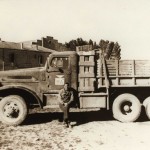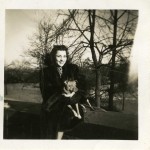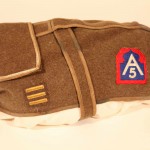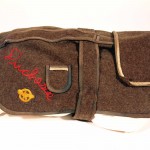National Dog Day – Duchess
In honor of National Dog Day, August 26th, the story of Duchess and her rescue seems fitting. National Dog day began as a way both to honor dogs and to help in their rescue from homeless and abusive situations. Duchess and her rescuer, Technical Sergeant Howard R. Synder, are a great example of a war time rescue.
The US military trained over 10,000 dogs for the war effort and sent some 2,000 overseas to serve in combat. They also made extensive use of mules, horses, and even pigeons for various types of war-related jobs. It is the companionship of animals, however, which should not be overlooked. Although many animals were used for work, they were also friends and a comfort to the men who worked alongside them. Many units, ships, and individuals picked up pets or mascots during their travels to serve as companions and friends. Mascots and other companion animals gave some light-hearted fun to the drudgery and fear that was often a part of life at sea or life in a combat zone. Dogs and cats were popular mascots, but servicemen adopted other, more exotic, pets like monkeys, donkeys, and birds.
T/Sgt. Howard R. Snyder was a truck driver for the Headquarters and Service Company of the 817th Engineer Aviation Battalion. He participated in many battles with the unit from Tunisia to the Rhineland. While on the island of Corsica, he found a small dog in an anti-aircraft gun emplacement and rescued her from the combat taking place around the emplacement. He dubbed her the “Duchess of Corsica” or just “Duchess” for short. The two became quick and steadfast companions. Duchess always rode next to Snyder in the truck, slept with him in his tent, and took cover with him under the truck when there was shelling or gunfire.
Duchess remained with Snyder for the remainder of the war and returned to the US with him aboard a Liberty ship. There were several soldiers bringing home their European-adopted companions on the ship, and the captain was not very happy about the dogs being on board. He made it clear that if any dogs made a mess on the deck, all the dogs would be thrown overboard. Snyder took his warning to heart and cleaned many messes on the deck that were not Duchess’s.
Upon their return to the US, Snyder made Duchess her own “uniform” using an Army blanket and some of his own insignia. She proudly marched in her uniform with Snyder at the very first Memorial Day parade held in Westbury, Long Island, after the war. Snyder’s son Howard M. Snyder remembers that his father was devoted to Duchess for her whole life. She lived to be eighteen years old. Like many veterans returning from war, Snyder often struggled with the events he had witnessed, but he took great comfort in Duchess’s company and in knowing that he had made a wonderful home for her in the US.
- Snyder with his truck. He and Duchess would often take cover under the truck when there was shelling or incoming fire. Italy 1944 Gift of Howard M. Snyder, 2012.259
- Snyder with his truck, Africa 1944 Gift of Howard M. Snyder, 2012.259
- Snyder ‘s wife, Rose, holds Duchess in her arms, New York 1948 Gift of Howard M. Snyder, 2012.259
- Duchess’s uniform, made by Snyder from an Army blanket and some of his insignia. Gift of Howard M. Snyder, 2012.259
- Duchess’s uniform, made by Snyder from an Army blanket and some of his insignia. Gift of Howard M. Snyder, 2012.259








